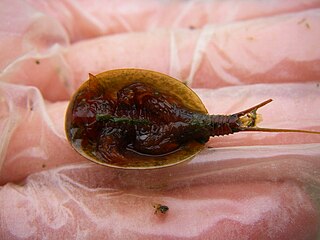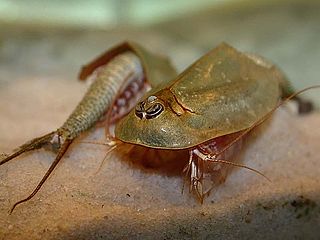
Branchiopoda is a class of crustaceans. It comprises fairy shrimp, clam shrimp, Cladocera, Notostraca and the Devonian Lepidocaris. They are mostly small, freshwater animals that feed on plankton and detritus.

A living fossil is an extant taxon that cosmetically resemble ancestral species known only from the fossil record. To be considered a living fossil, the fossil species must be old relative to the time of origin of the extant clade. Living fossils commonly are of species-poor lineages, but they need not be. While the body plan of a living fossil remains superficially similar, it is never the same species as the remote ancestors it resembles, because genetic drift would inevitably change its chromosomal structure.
Sea-Monkeys are a novelty aquarium pet, a type of brine shrimp that undergoes cryptobiosis. Developed in the United States in 1957, by Harold von Braunhut, the shrimp are intended to be added to water, and almost always come bundled in a 3-pouch kit with other required pouches and instructions. Sometimes a small tank and/or supplementary pouches may also be included with the product. The product was heavily marketed in the 1960s and 70s, especially in comic books, and remains a presence in popular culture.

The order Notostraca, containing the single family Triopsidae, is a group of crustaceans known as tadpole shrimp or shield shrimp. The two genera, Triops and Lepidurus, are considered living fossils, having not changed significantly in outward form since the Triassic. They have a broad, flat carapace, which conceals the head and bears a single pair of compound eyes. The abdomen is long, appears to be segmented and bears numerous pairs of flattened legs. The telson is flanked by a pair of long, thin caudal rami. Phenotypic plasticity within taxa makes species-level identification difficult, and is further compounded by variation in the mode of reproduction. Notostracans are omnivores living on the bottom of temporary pools and shallow lakes.

Triops is a genus of small crustaceans in the order Notostraca. Some species are considered living fossils, with a fossil record that reaches back to the late Carboniferous, 300 million years ago. The long lasting resting eggs of one species, Triops longicaudatus, are commonly sold in kits as a pet. In contact with fresh water the animals hatch. Most Triops have a life expectancy of up to 90 days, and can tolerate a pH range of 6–10. In nature they often inhabit temporary pools.

Triops longicaudatus is a freshwater crustacean of the order Notostraca, resembling a miniature horseshoe crab. It is characterized by an elongated, segmented body, a flattened shield-like brownish carapace covering two thirds of the thorax, and two long filaments on the abdomen. The genus name Triops comes from Ancient Greek ὤψ or ṓps, meaning "eye" prefixed with Latin tri-, "three", in reference to its three eyes. Longicaudatus is a Latin neologism combining longus ("long") and caudatus ("tailed"), referring to its long tail structures. Triops longicaudatus is found in freshwater ponds and pools, often in places where few higher forms of life can exist. Like its relative Triops cancriformis, the longtail tadpole shrimp is considered a living fossil because its basic prehistoric morphology has changed little in the last 70 million years, exactly matching their ancient fossils. Triops longicaudatus is one of the oldest animal species still in existence.

Lepidurus packardi, known by the common name vernal pool tadpole shrimp, is a rare species of tadpole shrimp (Notostraca).
Androdioecy is a reproductive system characterized by the coexistence of males and hermaphrodites. Androdioecy is rare in comparison to the other major reproductive systems: dioecy, gynodioecy and hermaphroditism. In animals, androdioecy has been considered an important stepping stone in the transition from dioecy to hermaphroditism, and vice versa.

Great Valley Grasslands State Park is a state park of California, United States, preserving a parcel of remnant native grassland in the San Joaquin Valley. Such a temperate grasslands, savannas, and shrublands biome was once widespread throughout the whole Central Valley. The 2,826-acre (1,144 ha) park was established in 1982. Largely undeveloped, it was formed by combining two former state park units: San Luis Island and Fremont Ford State Recreation Area. Its chief attractions for visitors are spring wildflowers, fishing, and wildlife watching.

Triops australiensis, sometimes referred to as a shield shrimp, is an Australian species of the tadpole shrimp Triops.

Triops newberryi is a species of Triops found on the western coast of North America, commonly in valleys throughout the states of Washington, Oregon, California, and small areas of Nevada, Utah, New Mexico, and Mexico, with at least one disjunct population in Kansas. They are found in vast numbers though in the Coachella Valley in California. T. newberryi has been reported to have potential as a biocontrol agent for larval mosquitoes breeding in seasonally-flooded habitats. T. newberryi is genetically distinct from T. longicaudatus, the dominant species in the Central United States.

Triops granarius is a species of tadpole shrimp with a broad distribution from Africa and the Middle East to China and Japan, although there are indications that it, as presently defined, is a species complex. They have elongated bodies and large flaps. Triops granarius can be kept as pets in home aquaria. Their life expectancy is up to 90 days, and in that time they can grow more than 6 cm in length.

Triops cancriformis, or tadpole shrimp, is a species of tadpole shrimp found in Europe to the Middle East and India.

Lepidurus arcticus is a species of tadpole shrimp which inhabits both ephemeral pools and permanent freshwater lakes of Norway, Greenland, Finland, Sweden, Svalbard, Iceland, Russia and the Kuril Islands.

Chenops is an extinct genus of notostracan which existed in the Yixian Formation, Inner Mongolia, and the Jehol fauna of China during the early Cretaceous period. The genus was erected by Thomas A. Hegna and Ren Dong in 2010 to describe the Yixian species, Chenops yixianensis. A second species, originally described as "Prolepidurus oblongus", from the Jehol fauna, was redescribed as C. oblongus.

Jeholops is an extinct genus of notostracan which existed in the Yixian Formation, inner Mongolia, China during the early Cretaceous period. It was described by Thomas A. Hegna and Ren Dong in 2010, and the only species is Jeholops hongi.

Lepidurus apus, commonly known as a tadpole shrimp, is a notostracan in the family Triopsidae, one of a lineage of shrimp-like crustaceans that have had a similar form since the Triassic period and are considered living fossils. This species is cosmopolitan, inhabiting temporary freshwater ponds over much of the world, and the most widespread of the tadpole shrimps. Like other notostracans, L. apus has a broad carapace, long segmented abdomen, and large numbers of paddle-like legs. It reproduces by a mixture of sexual reproduction and self-fertilisation of females.
Triops vincentinus is a species of freshwater crustacean tadpole shrimps.















